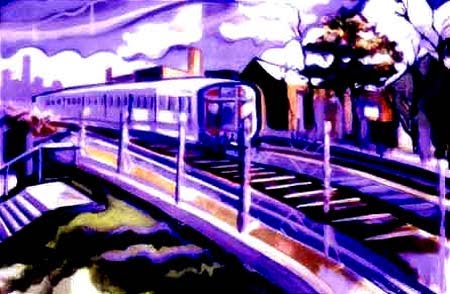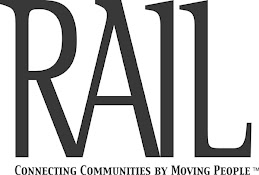 |
| Chicago Union Station |
Chicago has long been considered the premier city of American railroading. For more than 120 years, it has hosted the greatest numbers of rail miles and train movements for both passengers and freight, even in today's consolidated railroading environment.
Amtrak's presence in Chicagoland likewise speaks to its national importance, with trains departing to coastal terminal locations in Boston, New York, Washington, New Orleans, Los Angeles, Oakland, Portland and Seattle, as well as more regional destinations such as Detroit, Port Huron and Grand Rapids, Mich., Quincy and Carbondale, Ill., St. Louis and Kansas City, Mo., Milwaukee, Wisc., and Indianapolis, Ind. No other station in the United States offers such a geographic array of destinations.
Additionally, the Windy City hosts more active passenger rail stations than any other in North America. Sure, New York has the magnificent
Grand Central and the busy
Penn Station, Boston its
North and
South Stations, Baltimore can boast about its
Penn and
Camden Stations, Philadelphia with the trio of
30th Street,
Suburban and
Market East and, up north, Montreal and Vancouver each maintain two terminals apiece. However, no city can claim it supports four stations serving daily passenger trains except Chicago and its quartet of Union Station, the Ogilvie Transportation Center, LaSalle Station and the recently rehabilitated Millennium Station. We'll take a look at each of these important transportation nodes and how they function together to serve Chicago.
 |
| Union Station's Great Hall still speaks to the grandeur of Burnham's design |
Union Station
 |
| Union Station with its original 1924 concourse |
RAIL Magazine's interest in Chicago's premier rail terminal began in our first edition and continued in our
18th issue (which also focused on the larger
passenger rail network in Chicagoland). For an extensive profile of Union Station, you'd do best to read through those profiles. As an overview, no intercity passenger rail station between the east and west coasts hosts more passengers than this 1925 vintage facility. Home to 17 different Amtrak routes and six
Metra commuter rail lines, more than 50,000 people pass through the station every day. While there is not a Chicago Transit Authority (CTA) L station directly connected to Union Station, there are several within walking distance. Designed by famed Chicago architect
Daniel Burnham – he of the "make no small plans" quote fame – and restored in 1991 with a new concourse after its original version was demolished in 1969, the station is not only well-suited to accommodate its current scores of daily patrons, but also to serve as the centerpiece for expanded high-speed and intercity passenger rail service throughout the Midwest.
 |
| Ogilvie Transportation Center |
Ogilvie Transportation Center
 |
| Chicago & Northwestern Terminal |
While Union Station was originally built to serve the operations of numerous independent railroads in Chicago, it did not serve them all. One railroad that maintained its own facility was the
Chicago & Northwestern (C&NW), which wanted a distinct presence in its hometown. As a result, the railroad constructed its namesake terminal in 1911 at Madison and Clinton streets on the west side of the Chicago River. Not only did C&NW trains such as the
North Western Limited or the
Dakota 400 call at the station, but so did joint C&NW-Union Pacific trains like the
Overland Limited and the
City of Los Angeles. The main terminal building stood at the location until 1984, when a new hi-rise office building to house Citicorp was constructed in its place. A new passenger station was included in the facility, which was subsequently renamed after Richard B. Ogilvie in 1997. Ogilvie was a board member of the Milwaukee Road and Governor of Illinois who was influential in the establishment of the Regional Transportation Authority. Metra assumed the commuter rail services of the C&NW – whose rail lines would eventually be acquired by the Union Pacific – and today, the
Ogilvie Transportation Center hosts the Union Pacific West, Northwest and West lines to Elburn, Harvard/McHenry and Kenosha, Wisc., respectively. All told, these lines deliver more than 41,000 daily passengers to the 16-track station, and several L stops are nearby but, again, not directly attached to the depot.
 |
| LaSalle Station |
LaSalle Station
 |
| The original LaSalle Station |
Like the Ogilvie Transportation Center, LaSalle Station – at LaSalle Street and Congress Parkway – was built by railroads uninterested in locating at the Union Station joint facility. The
New York Central and
Rock Island railroads took over an existing station in the east side of the Chicago River and co-located their operations at the site, which was formalized with a new station building in 1903. Both carriers sent trains to LaSalle until the New York Central merged with the Pennsylvania in 1968 to form the Penn Central, after which its trains called at Union Station. The Rock Island continued service to LaSalle until the Regional Transportation Authority purchased its commuter rail operation in 1976 – although it was operated by the Chicago & Northwestern until 1981, when it was integrated into the Metra network. Today, Metra's Rock Island District carries more than 32,000 daily passengers on two branches between LaSalle and Blue Island, with others extending the full route to Joliet. The L is accessible via the LaSalle/Van Buren station just about a block away, while the Blue Line subway's LaSalle station is a block to the east.
 |
| Millennium Station after its 2005 refurbishment |
Millennium Station
 |
| Illinois Central's Randolph Street Terminal |
Anywhere west of Harrisburg, Penn., there is only one terminal station where electrically-powered intercity or commuter trains operate in North America: Chicago's Millennium Station (although this factoid may prove a fleeting one should expected high-speed and intercity rail projects currently planned come to fruition; the first will most likely be the electrification of the Caltrain service between San Francisco and San Jose). The Illinois Central (IC) Railroad established its Chicago terminal at Randolph and South Water streets just east of The Loop in 1893, and electrified its commuter rail trackage in 1926 with routes stretching to South Chicago, Blue Island and University Park. Known then as Randolph Street Terminal, the station also hosted the interurban trains of the Chicago, South Shore and South Bend Railroad (South Shore). Metra assumed the IC's routes in 1987 and rebranded them as
Metra Electric, while the South Shore was acquired by the Northern Indiana Commuter Transportation District (NICTD) in 1989 (for full details on the last surviving interurban, the South Shore Line, see Beth Wilson's excellent profile in the first edition of RAIL Magazine). Today, more than 18,000 daily riders travel through Millennium Station, which was renamed to correspond with the park built over its tracks bearing the same name after a substantial rehabilitation in 2005 improved the station with shops, food service, waiting areas, ticket windows and other amenities.
Coming soon will be a photo collection from the various stations....














No comments:
Post a Comment